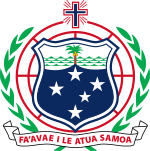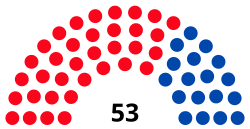Legislative Assembly of Samoa Fono Aoao Faitulafono o Samoa | |
|---|---|
| 17th Parliament | |
 | |
| Type | |
| Type | |
| History | |
| Founded | 1 January 1962 |
| Leadership | |
Tuimalealiʻifano Vaʻaletoʻa Sualauvi II since 21 July 2017 | |
Papali’i Li’o Taeu Masipau since 24 May 2021 | |
Deputy Speaker | |
Deputy Prime Minister | |
| Structure | |
| Seats | 53 |
 | |
Political groups | Government (35)
Official opposition (18)
|
Length of term | Up to 5 years |
| Elections | |
| First-past-the-post | |
Last election | 9 April 2021 |
Next election | On or before April 2026 |
| Meeting place | |
 | |
| Maota, Tiafau, Apia[2] | |
| Website | |
| www | |
The Legislative Assembly (Samoan: Fono Aoao Faitulafono a Samoa), also known as the Parliament of Samoa (Samoan: Palemene o Samoa), is the national legislature of Samoa, seated at Apia, where the country's central administration is situated. Samoan Parliament is composed of two parts: the O le Ao o le Malo (head of state) and the Legislative Assembly.
In the Samoan language, the Legislative Assembly of Samoa is sometimes referred to as the Samoan Fono while the government of the country is referred to as the Malo. The word fono is a Samoan and Polynesian term for councils or meetings great and small and applies to national assemblies and legislatures, as well as local village councils.
The modern government of Samoa exists on a national level alongside the country's fa'amatai indigenous chiefly system of governance and social organisation.[3] In his or her own right, the O le Ao o le Malo can summon and call together the Legislative Assembly, and can prorogue or dissolve Parliament, in order to either end a parliamentary session or call a general election on behalf of the Prime Minister of Samoa.
- ^ Matai'a Lanuola Tusani T - Ah Tong (5 July 2023). "Speaker to recognise Tuilaepa as Opposition Leader". Samoa Observer. Retrieved 19 July 2023.
- ^ "Legislative Assembly of Samoa" (PDF). Office of the Clerk. Archived from the original (PDF) on 17 April 2017.
- ^ Fana'afi Le Tagaloa, Aiono (1986). Land rights of Pacific women. University of the South Pacific;Institute of Pacific Studies. p. 103. ISBN 982-02-0012-1.